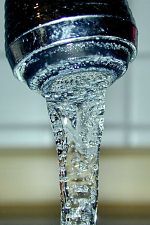
The dangers of chromium-6 became widely known after Pacific Gas & Electric Corp. was accused of leaking the contaminant into the groundwater of Hinckley, a small desert town, causing health problems of the inhabitants of the area surrounding the PG&E utility. A year later in 2001, the California Legislature directed public health agencies to set an enforceable drinking water standard for the chemical by 2004. The process was delayed due to a scientific dispute over whether chromium-6 is carcinogenic when ingested (see the EVISA News below). While it has long been established that chromium-6 is carcinogenic when inhaled (e.g.by welders), it was only in 2007 that federal scientists at the National Toxicology Program confirmed that hexavalent chromium is also carcinogenic when ingested.
The California EPA then set a preliminary benchmark in creating a drinking water standard. But in 2010, the agency recommended even stricter limits after research showed that fetuses, infants and children are more susceptible than adults to the effects of the chemical. That goal was set last year at .02 parts per billion of hexavalent chromium in water (see the EVISA News below).
There is no federal standard for chromium-6. Last year, the U.S. EPA released recommendations for enhanced monitoring of the chemical in public water systems and is conducting a review of chromium-6 to decide whether to set a nationwide standard (see the EVISA News below).
The proposed standardA judge on July 31 ordered the state Department of Public Health to propose the standard for hexavalent chromium, or chomium-6, by the end of August. According to the news release of the Department of Public Health the newly proposed standard is about five times stricter than existing rules:
“The proposed regulations set the maximum contaminant level (MCL) for chromium-6 in drinking water at 10 parts per billion (ppb) and specifically regulate the hexavalent form of chromium. This is five times less than the current total chromium standard of 50 ppb, which includes both trivalent chromium (chromium-3) and chromium-6. The federal MCL for total chromium is 100 ppb. Chromium-3 is harmless and actually a required nutrient, while chromium-6 may pose a risk of cancer when ingested.”
At 10 parts per billion, the maximum contaminant level is 500 times greater than the non-enforceable public health goal set by the state Environmental Protection Agency in 2011. The Department of Public Health described the proposed limit as a balance of public health, cost and treatment technology, but the agency acknowledged that economics were a key consideration.
Public comment on the proposal began last Friday and ends at 5:00 pm on October 11, 2013 on the website of the Office of Administrative Law (OAL).